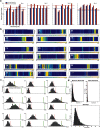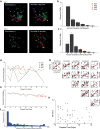In Vivo Multi-Day Calcium Imaging of CA1 Hippocampus in Freely Moving Rats Reveals a High Preponderance of Place Cells with Consistent Place Fields
- PMID: 35501152
- PMCID: PMC9172072
- DOI: 10.1523/JNEUROSCI.1750-21.2022
In Vivo Multi-Day Calcium Imaging of CA1 Hippocampus in Freely Moving Rats Reveals a High Preponderance of Place Cells with Consistent Place Fields
Abstract
Calcium imaging using GCaMP indicators and miniature microscopes has been used to image cellular populations during long timescales and in different task phases, as well as to determine neuronal circuit topology and organization. Because the hippocampus (HPC) is essential for tasks of memory, spatial navigation, and learning, calcium imaging of large populations of HPC neurons can provide new insight on cell changes over time during these tasks. All reported HPC in vivo calcium imaging experiments have been done in mouse. However, rats have many behavioral and physiological experimental advantages over mice. In this paper, we present the first (to our knowledge) in vivo calcium imaging from CA1 HPC in freely moving male rats. Using the UCLA Miniscope, we demonstrate that, in rat, hundreds of cells can be visualized and held across weeks. We show that calcium events in these cells are highly correlated with periods of movement, with few calcium events occurring during periods without movement. We additionally show that an extremely large percent of cells recorded during a navigational task are place cells (77.3 ± 5.0%, surpassing the percent seen during mouse calcium imaging), and that these cells enable accurate decoding of animal position and can be held over days with consistent place fields in a consistent spatial map. A detailed protocol is included, and implications of these advancements on in vivo imaging and place field literature are discussed.SIGNIFICANCE STATEMENT In vivo calcium imaging in freely moving animals allows the visualization of cellular activity across days. In this paper, we present the first in vivo Ca2+ recording from CA1 hippocampus (HPC) in freely moving rats. We demonstrate that hundreds of cells can be visualized and held across weeks, and that calcium activity corresponds to periods of movement. We show that a high percentage (77.3 ± 5.0%) of imaged cells are place cells, and that these place cells enable accurate decoding and can be held stably over days with little change in field location. Because the HPC is essential for many tasks involving memory, navigation, and learning, imaging of large populations of HPC neurons can shed new insight on cellular activity changes and organization.
Keywords: Ca1; calcium imaging; hippocampus; miniscopes; place cells; rats.
Copyright © 2022 the authors.
Figures






Similar articles
-
Hippocampal place cell remapping occurs with memory storage of aversive experiences.Elife. 2023 Jul 19;12:e80661. doi: 10.7554/eLife.80661. Elife. 2023. PMID: 37466236 Free PMC article.
-
Place cells are nonrandomly clustered by field location in CA1 hippocampus.Hippocampus. 2023 Feb;33(2):65-84. doi: 10.1002/hipo.23489. Epub 2022 Dec 15. Hippocampus. 2023. PMID: 36519700 Free PMC article.
-
Hippocampal Place Fields Maintain a Coherent and Flexible Map across Long Timescales.Curr Biol. 2018 Nov 19;28(22):3578-3588.e6. doi: 10.1016/j.cub.2018.09.037. Epub 2018 Nov 1. Curr Biol. 2018. PMID: 30393037 Free PMC article.
-
Advances of optical miniscopes for in vivo imaging of neural activity in freely moving animals.Front Neurosci. 2022 Sep 7;16:994079. doi: 10.3389/fnins.2022.994079. eCollection 2022. Front Neurosci. 2022. PMID: 36161177 Free PMC article. Review.
-
The Representation of Three-Dimensional Space in Fish.Front Behav Neurosci. 2016 Mar 8;10:40. doi: 10.3389/fnbeh.2016.00040. eCollection 2016. Front Behav Neurosci. 2016. PMID: 27014002 Free PMC article. Review.
Cited by
-
Miniscope-LFOV: A large-field-of-view, single-cell-resolution, miniature microscope for wired and wire-free imaging of neural dynamics in freely behaving animals.Sci Adv. 2023 Apr 21;9(16):eadg3918. doi: 10.1126/sciadv.adg3918. Epub 2023 Apr 21. Sci Adv. 2023. PMID: 37083539 Free PMC article.
-
Current Status and Future Strategies for Advancing Functional Circuit Mapping In Vivo.J Neurosci. 2023 Nov 8;43(45):7587-7598. doi: 10.1523/JNEUROSCI.1391-23.2023. J Neurosci. 2023. PMID: 37940594 Free PMC article.
-
Advances in cellular resolution microscopy for brain imaging in rats.Neurophotonics. 2023 Oct;10(4):044304. doi: 10.1117/1.NPh.10.4.044304. Epub 2023 Nov 30. Neurophotonics. 2023. PMID: 38076724 Free PMC article. Review.
-
Examining a punishment-related brain circuit with miniature fluorescence microscopes and deep learning.Addict Neurosci. 2024 Jun;11:100154. doi: 10.1016/j.addicn.2024.100154. Epub 2024 Apr 16. Addict Neurosci. 2024. PMID: 38680653 Free PMC article.
-
Hippocampal place cell remapping occurs with memory storage of aversive experiences.Elife. 2023 Jul 19;12:e80661. doi: 10.7554/eLife.80661. Elife. 2023. PMID: 37466236 Free PMC article.
References
-
- Ahanonu B (2018) CIAtah: a software package for analyzing one- and two-photon calcium imaging datasets, v1.0.0 Edition. Zenodo.
Grants and funding
LinkOut - more resources
Full Text Sources
Miscellaneous
